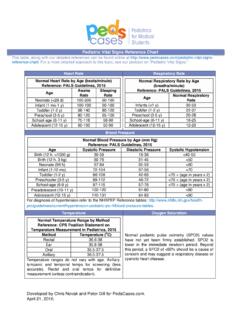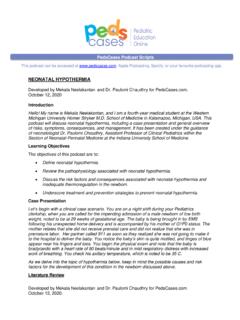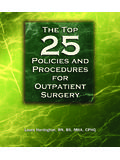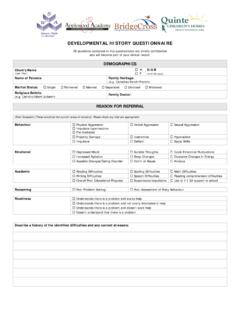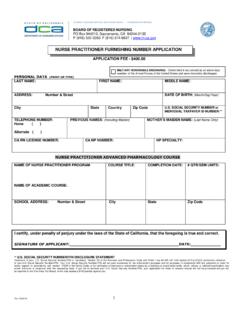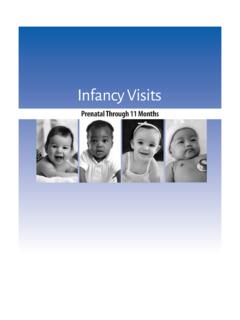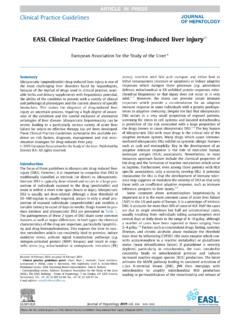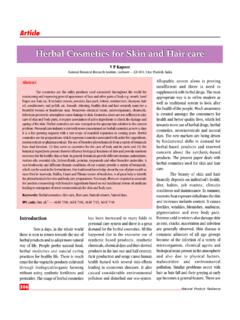Transcription of pediatric history taking - PedsCases
1 Developed by Alanna Chomyn & Karen Forbes for November 14, 2015 pediatric history taking Developed by Alanna Chomyn and Dr. Karen Forbes for November 14, 2015 Introduction: Hello this is Alanna Chomyn and I am a 4th year medical student at the University of Alberta. This podcast was created with Dr. Karen Forbes, a pediatrician and medical educator at the University of Alberta and the Stollery Children s Hospital. In this podcast, we will review the components of a complete pediatric history tailored to the age of the child. By the end of this podcast you should understand the importance of certain components of the pediatric history at different ages, and have an age-appropriate approach to pediatric history taking .
2 We will start off this podcast by reviewing the major elements of a complete pediatric history , and later will compare and contrast specific elements required when taking a history for patients at different ages. At the end, we will provide tips and tricks for conducting a pediatric interview, as offered by a range of experienced pediatricians at the Stollery Children s Hospital. Our discussion will begin with a brief scenario. You are a third year clerk on your pediatrics rotation at an ambulatory clinic. Your preceptor asks you to see Katie, a 3-month-old girl presenting with her mother for her well-baby check. What are the important components of the history for Katie? The basic components of a pediatric history are as follows: history of presenting illness, past history including prenatal, birth, and postnatal history , past medical history , surgical history , growth and developmental, medications, allergies, immunizations, family history , social history and review of systems.
3 We will now discuss each of these components in further detail. history of Presenting Illness: Similar to history taking in the adult population, the history of presenting illness in a pediatric history explores the patient s primary concern or concerns, and must be tailored to the individual presenting complaint. Generally, you will want to try to characterize the symptoms of concern and get a sense of the onset, timing, aggravating and alleviating factors, associated symptoms, and if anything similar has happened to PedsCases Podcast Scripts This is a text version of a podcast from on the Approach to pediatric Anemia and Pallor. These podcasts are designed to give medical students an overview of key topics in pediatrics.
4 The audio versions are accessible on iTunes or at Developed by Alanna Chomyn & Karen Forbes for November 14, 2015 the patient before. In a well-child visit, the HPI may be focused on concerns the family has had regarding the health and development of the child and a follow up on previously addressed issues. Past history : The past history establishes a complete picture of the child s health to date, and should cover events from the prenatal period until the child s current presentation. The prenatal history includes inquiring about maternal age, and number of previous pregnancies and the outcomes of those pregnancies. It may be relevant to ask if the child is a product of natural conception, or if assistive reproductive technology was required.
5 Ask about whether prenatal care was accessed, and if there were any abnormal results or concerns identified on routine screening or ultrasounds. You may inquire into if there were any complications in the pregnancy such as infections, diabetes, hypertension, or bleeding. Specifically, asking about group B strep screening in late pregnancy, as well as maternal symptoms of herpes simplex infection are important for newborns presenting with symptoms that may be concerning for neonatal sepsis. Asking about prenatal exposures including prescription medications, substances, and other toxins can be a sensitive topic, but can provide important insight into possible teratogens the child may have been exposed to, as well as potential ongoing risks to the child.
6 Start with asking about least threatening exposures first, and working your way towards more sensitive topics such as alcohol or drug use during pregnancy. Approaching this topic in a non-judgmental fashion is key in both obtaining a reliable history and maintaining rapport with the family. Additional exposures that may be relevant include the mother s occupation, such as working in a daycare during pregnancy, pets, and travel. The next component of past history is the birth history . You will want to ask about whether onset of labour, was spontaneous or induced, and the gestational age at time of delivery. Intrapartum risk factors should be asked, including duration of rupture of membranes, presence of maternal fever or fetal tachycardia, and whether amniotic fluid was mecounium stained.
7 Asking about mode of delivery will clarify if the infant was delivered by vaginal delivery, and if any instrumentation such as forceps or suction were required, or if delivery was by cesarean section. These elements of history provide important information as to potential issues after birth. Furthermore, ask about any complications that may have occurred during delivery. Following the birth history is the postnatal history , which covers details about the wellbeing of the child immediate postnatal period including APGAR scores if known, birth weight, and if any resuscitation was required. The APGAR scoring system is an assessment tool used to assess the wellbeing of an infant in the minutes immediately after birth.
8 It combines an assessment of the infant s colour, heart rate grimace or reflex, tone and respiratory effort. Each of these 5 components of the APGAR score are graded on a scale of 0-2, and the results are added to provide total score out of 10. Low APGAR scores are an indicator of poor infant wellbeing in the immediate postnatal period. For further information on the APGAR scoring system, please refer to our PedsCases podast entitled APGAR scoring system . In asking about the baby s health Developed by Alanna Chomyn & Karen Forbes for November 14, 2015 in the immediate postnatal period, you may ask if the baby was born healthy, and if there were any health issues in the prostnatal period such as respiratory problems or jaundice.
9 One other way to help determine if there were any concerns in the postnatal period is to ask how long the baby was admitted to hospital following delivery, and if the baby required care in the neonatal intensive care unit. Typically, healthy infants in Canada can be discharged home within 1-2 days of a vaginal delivery, or 2-3 days following a cesarean section, as the mother requires a longer stay for monitoring. If the family reports that the baby was in hospital for longer than you would expect, it is important to determine if the stay was extended for maternal or infant reasons, and what the reason for prolonged admission was and how it was managed. In past medical history , ask the family about any medical conditions the child has had, including any chronic conditions, past hospitalizations or emergency department visits or visits to medicentres or other health care providers.
10 For past surgical history , it may be relevant to include circumcision and/or dental surgeries in an older child. Growth history : Growth history is an important part of the pediatric history as prolonged illness or chronic conditions may impact the child s growth and result in deviations from an established growth trajectory. When asking about growth history , the pattern of growth, not just the child s measurement at the present is key as alterations in pattern of growth are often early signs of pathology. Plot the child s growth on a growth chart, and look at both numbers and percentiles. It may be helpful to ask regarding growth and size of family members, as marked deviations in a child s growth from what is expected from family trends could help in distinguishing constitutional or familial variants from a pathologic growth pattern.
